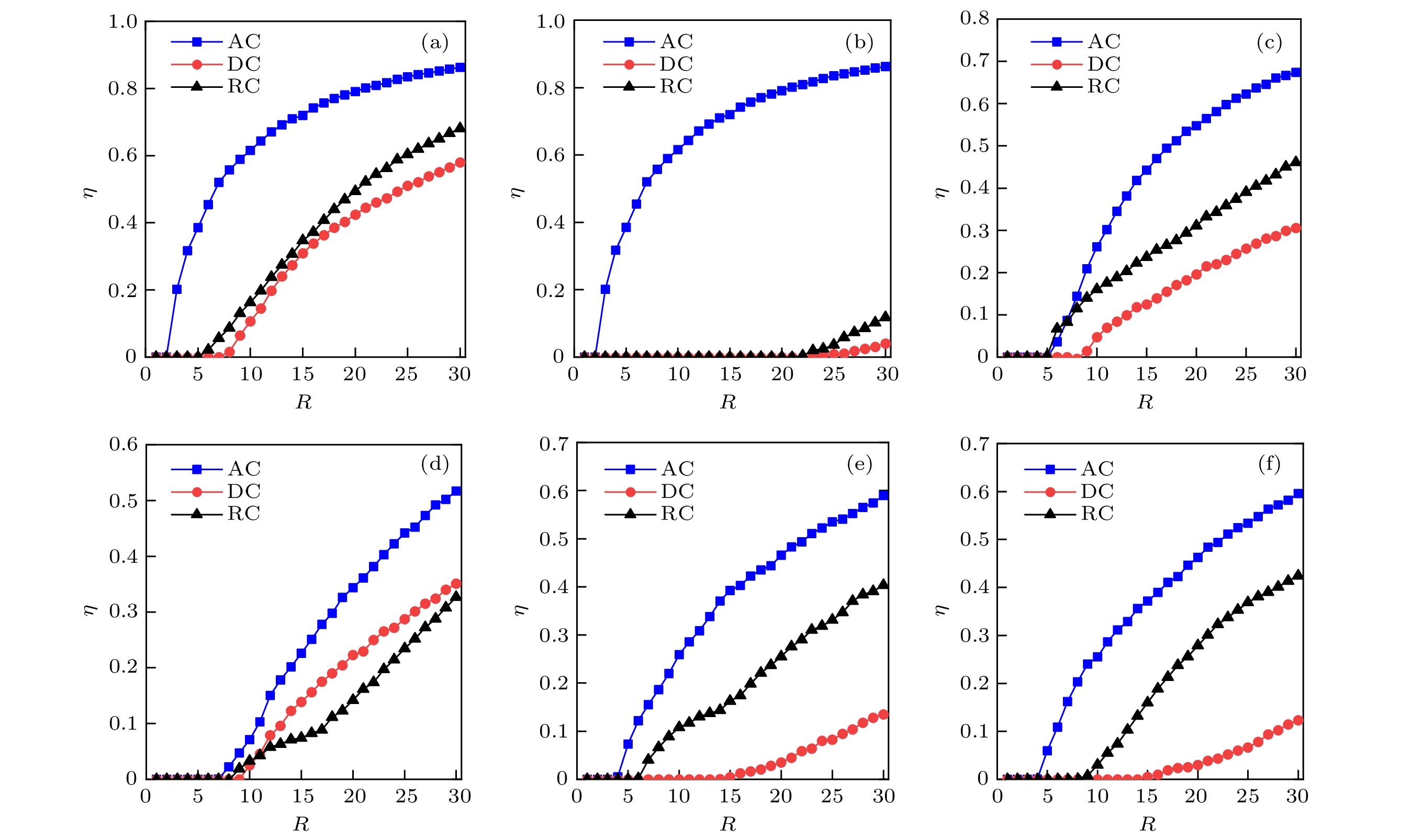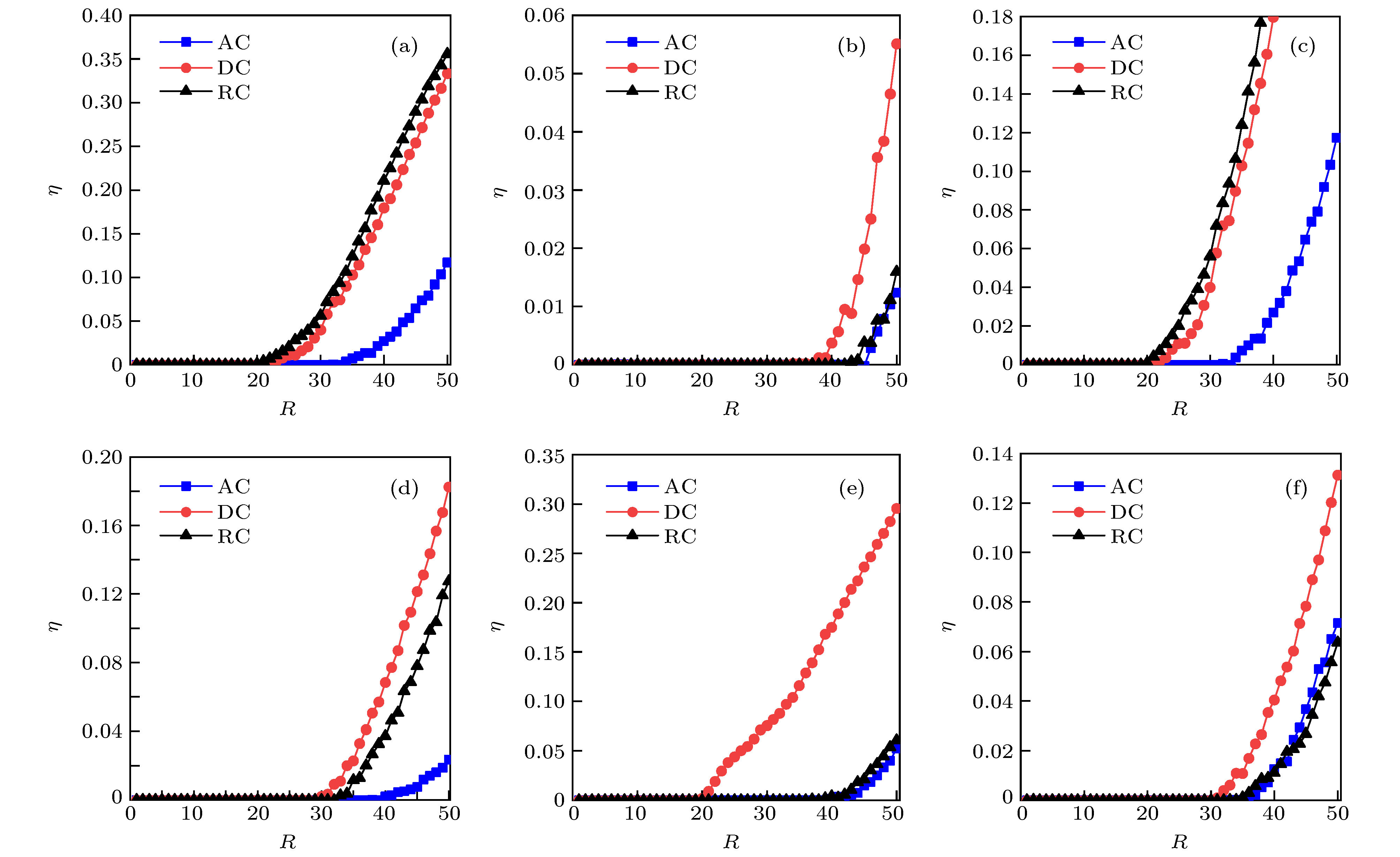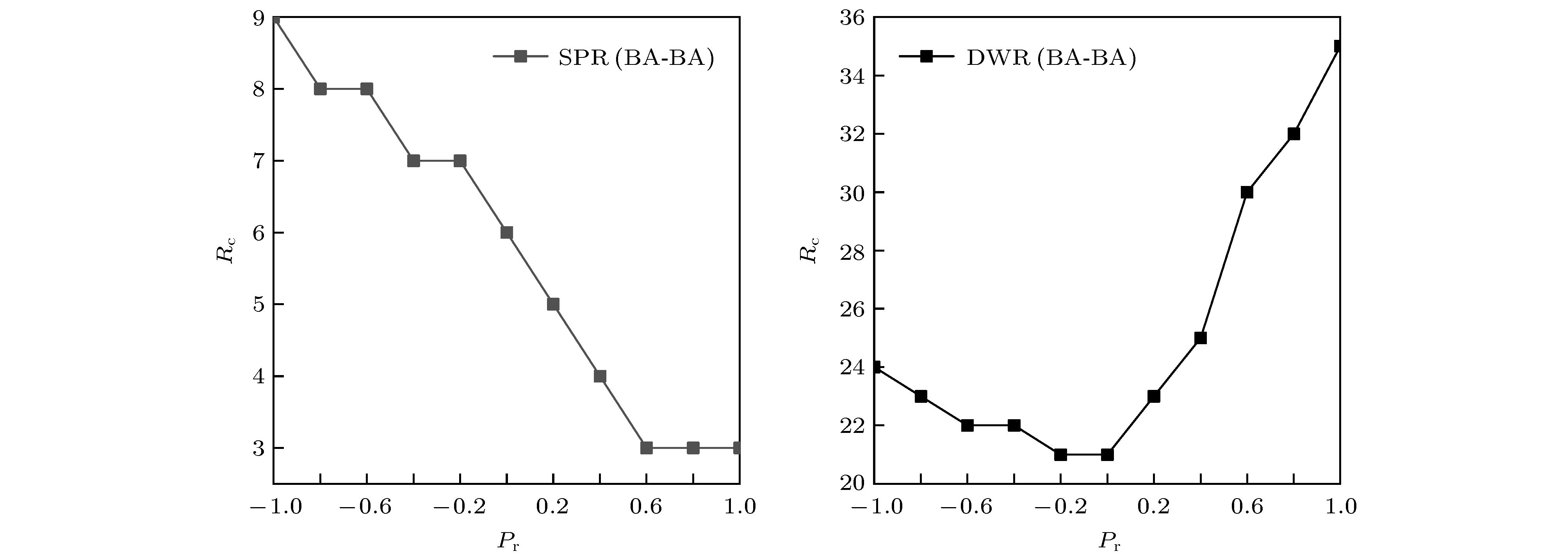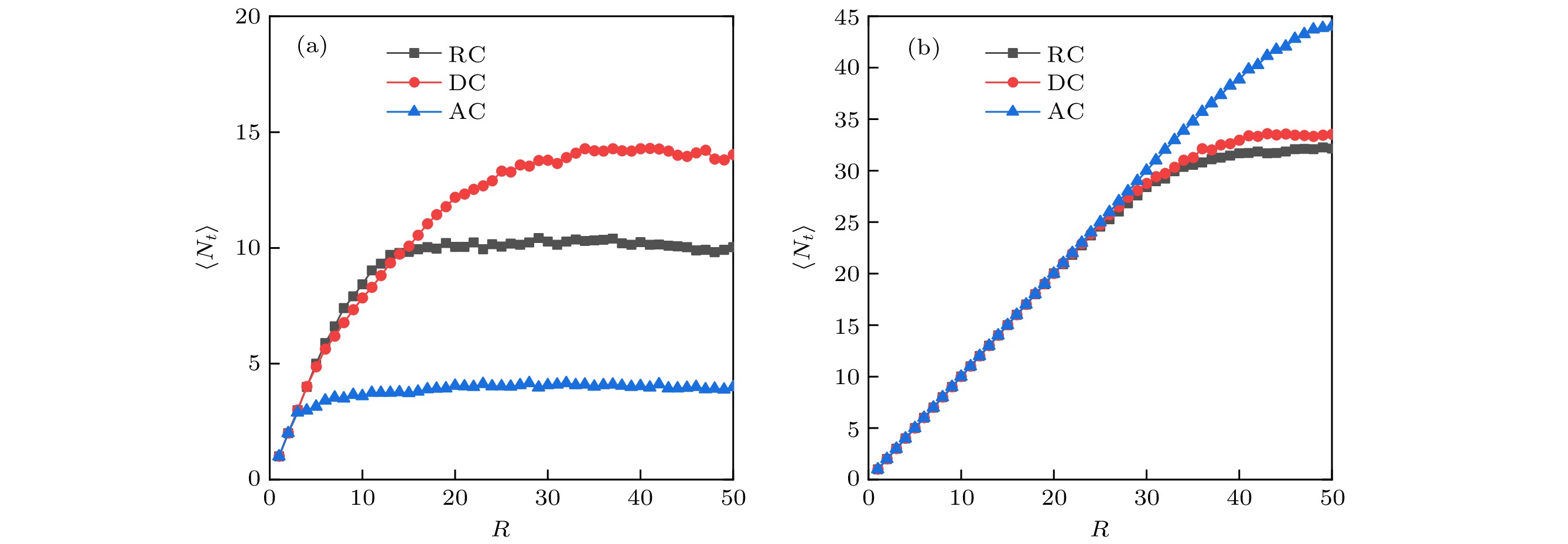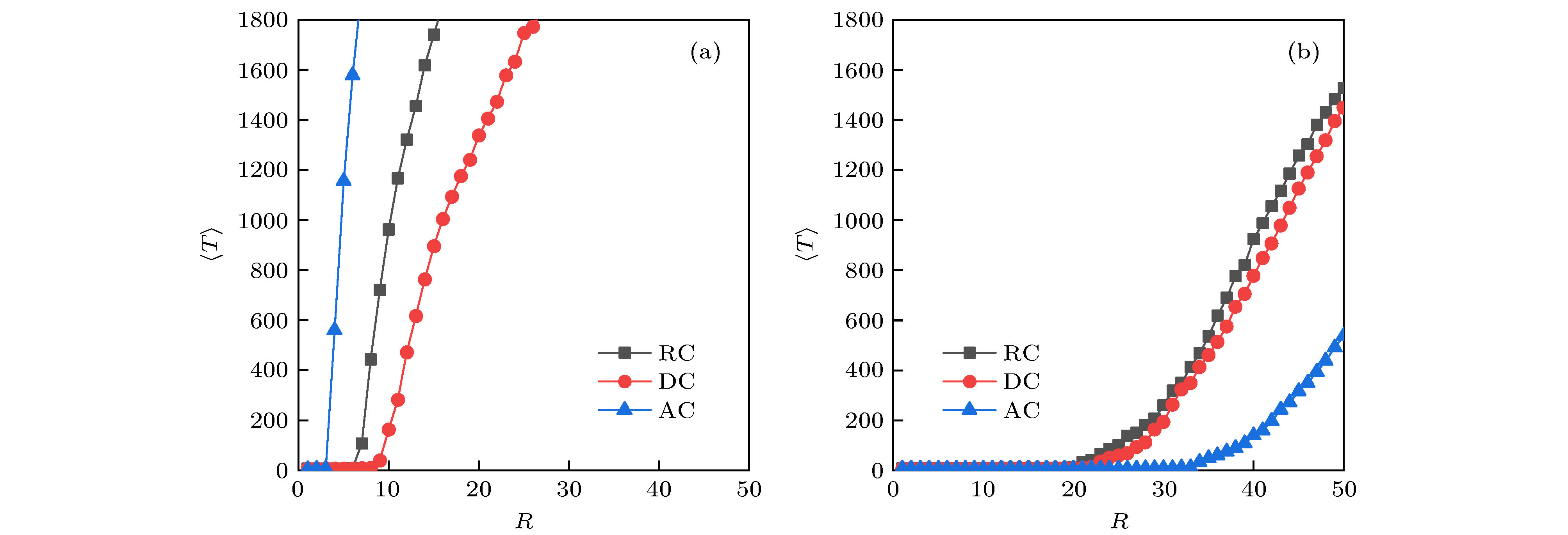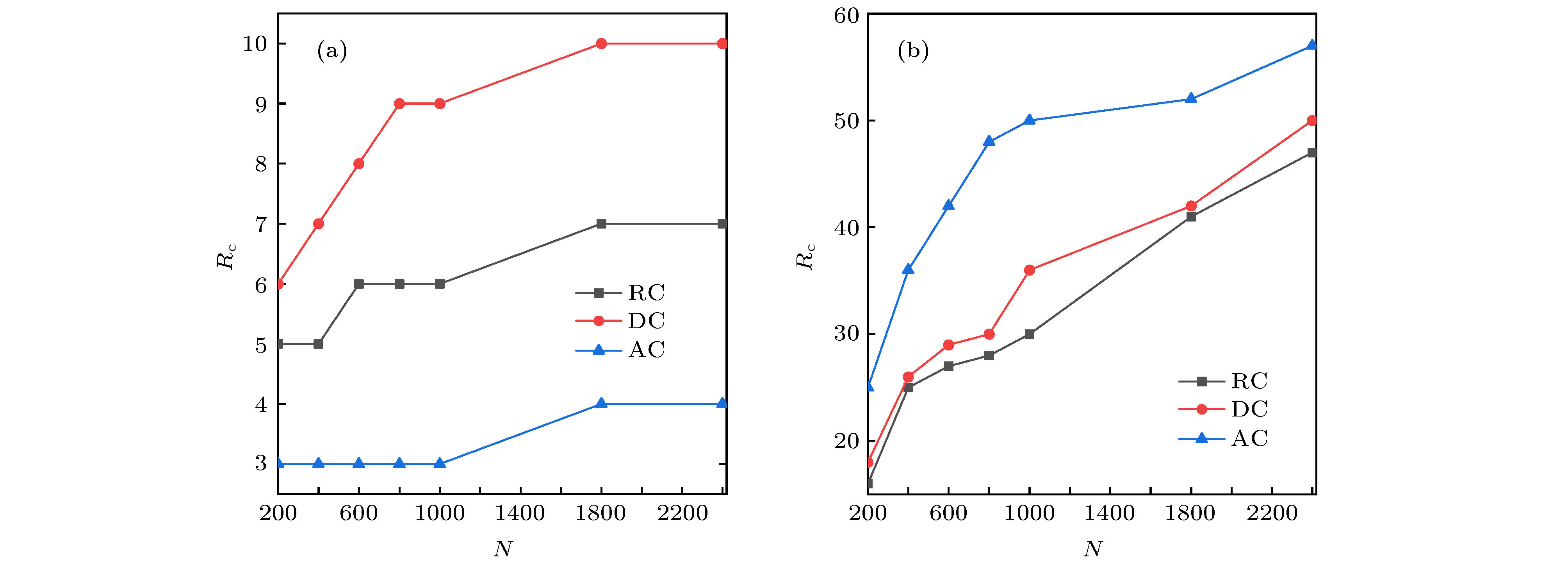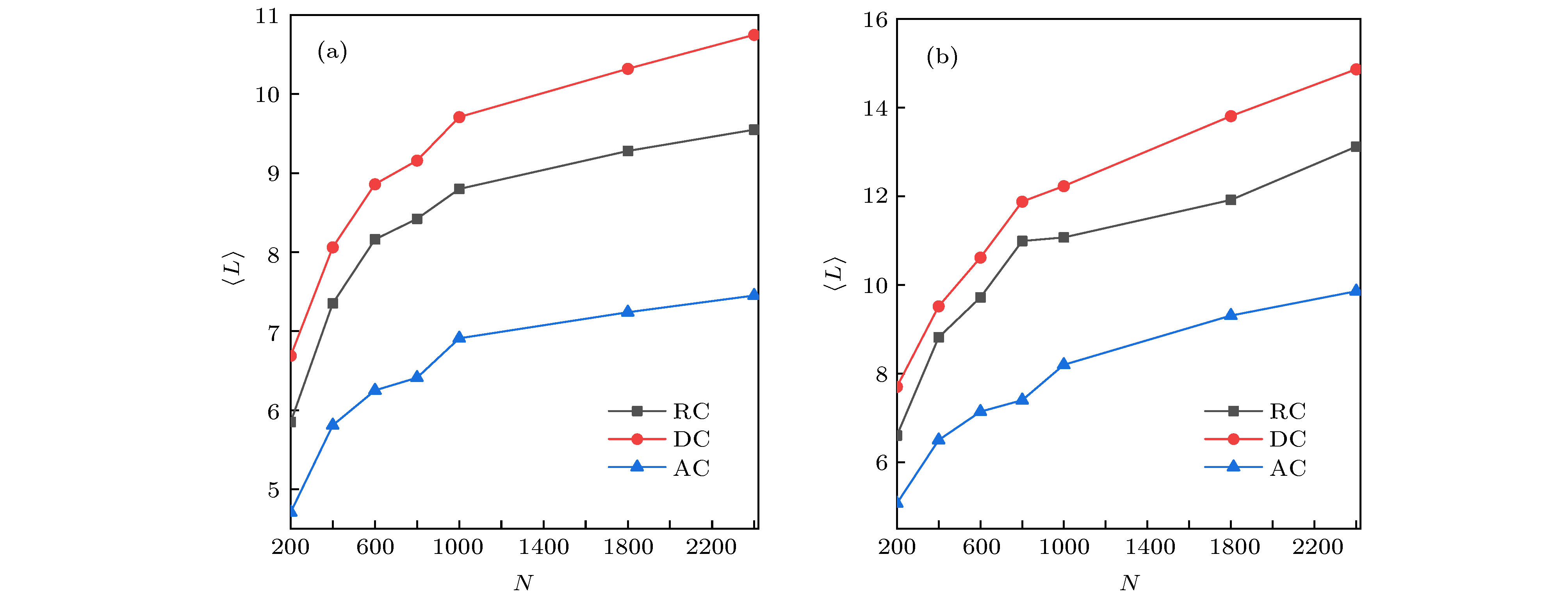-
为了降低网络拥塞, 提升网络传输性能, 对双层网络之间的耦合机理进行研究, 层间关系依据度度相关性分成三种耦合方式: 随机耦合、异配耦合、同配耦合. 在基于最短路径路由策略和基于度的权重路由策略条件下, 分析网络数据包的传输过程, 并研究双层网络的耦合方式及其适合的路由策略对网络传输容量的影响. 采用双层无标度网络进行仿真实验, 分析在路由策略约束下传输容量和耦合方式之间的关系, 依据双层网络之间耦合方式的特点, 找出适合每一种路由策略的最佳耦合方式以提升网络的传输容量. 经过仿真发现, 采用最短路径路由策略时, 异配耦合方式最佳; 采用基于度的静态权重路由策略时, 同配耦合方式最佳. 路由策略在匹配的耦合方式下使得网络流量分配均匀, 有利于网络传输容量的提升. 本研究为实际网络设计和传输性能优化提供了理论基础.The two-layer network model offers us a new viewpoint to observe the traffic dynamics of multilayer network systems. An efficient coupling mechanism is of great importance for alleviating the traffic congestion on two-layer networks. In order to reduce the network congestion and improve network transmission performance, the coupling mechanism between two layers of network and three coupling methods, which are random coupling, disassortative coupling and assortative coupling, are studied based on degree correlation. The packet transmission process is analyzed with both the shortest path routing strategy and degree-based weight routing strategy. The influences of the coupling mode and its corresponding routing strategy on the traffic capacity of the two-layer network are studied. In this paper, two scale-free networks are used to construct the two-layer network for simulation experiments. The network scale is in a range from 200 to 2400 with the value of average degree being 8. We focus on the traffic dynamics of two-layer network, and analyze the relationship between the traffic capacity and the three coupling modes, which are random coupling, disassortative coupling and assortative coupling, under the constraints of the shortest path routing strategy and the weight-based routing strategy. According to the characteristics of the coupling connection between the two layers of network, the best coupling method which is suitable for a certain routing strategy should be investigated. The suitable coupling connection between the two layers can effectively increase the traffic capacity. Both numerical result and analytical result show that the packet generation rate, average transmission time, and average throughput can be obviously improved under the shortest path routing strategy with the disassortative coupling method. When the degree-based static weight routing strategy is used, the traffic performance parameters such as packet generation rate, average transmission time, and average throughput can reach the optimal values with the assortative coupling method. It makes the traffic flow uniform that the routing strategy is chosen with the most suitable coupling method on the two-layer network, and the network traffic capacity may be effectively enhanced. More generally, the results indicate that the coupling modes can give rise to traffic behavior that relies subtly on the routing strategy on the two-layer network. Our work may shed some light on the design and optimization of some real traffic or communication networks.
-
Keywords:
- coupling network /
- traffic capacity /
- coupling strength /
- average path length
[1] Janaki T M, Gupte N 2003 Phy. Rev. E 67 021503
 Google Scholar
Google Scholar
[2] Albert R, Jeong H, Barabási A L 1999 Nature 401 130
 Google Scholar
Google Scholar
[3] 刘宏鲲, 周涛 2007 物理学报 56 106
 Google Scholar
Google Scholar
Liu H K, Zhou T 2007 Acta Phys. Sin. 56 106
 Google Scholar
Google Scholar
[4] Ohira T, Sawatari R 1998 Phy. Rev. E 58 193
 Google Scholar
Google Scholar
[5] Solé R V, Valverde S 2001 Physica A 289 595
 Google Scholar
Google Scholar
[6] Guimerà R, Arenas A, Díaz G A, Giralt F 2002 Phy. Rev. E 66 026704
 Google Scholar
Google Scholar
[7] Woolf M, Arrowsmith D K, Mondragón C R J, Pitts J M 2002 Phy. Rev. E 66 046106
 Google Scholar
Google Scholar
[8] Arenas A, Díaz G A, Guimerà R 2001 Phys. Rev. Lett. 86 3196
 Google Scholar
Google Scholar
[9] Du W B, Wu Z X, Cai K Q 2013 Physica A 392 3505
 Google Scholar
Google Scholar
[10] 陈华良, 刘忠信, 陈增强, 袁著祉 2009 物理学报 58 6068
 Google Scholar
Google Scholar
Chen H L, Liu Z X, Chen Z Q, Yuan Z Z 2009 Acta Phys. Sin. 58 6068
 Google Scholar
Google Scholar
[11] Zhou J, Yan G, Lai C H 2013 EPL-Europhys. Lett. 102 28002
 Google Scholar
Google Scholar
[12] Kurant M, Thiran P, Hagmann P 2007 Phys. Rev. E 76 026103
 Google Scholar
Google Scholar
[13] Du W B, Zhou X L, Chen Z, Cai K Q, Cao X B 2014 Chaos, Solitons Fractals 68 72
 Google Scholar
Google Scholar
[14] Tan F, Wu J J, Xia Y X, Tse C K 2014 Phys. Rev. E 89 062813
 Google Scholar
Google Scholar
[15] Kurant M, Thiran P 2006 Phys. Rev. Lett. 96 138701
 Google Scholar
Google Scholar
[16] Morris R G, Barthelemy M 2012 Phys. Rev. Lett. 109 128703
 Google Scholar
Google Scholar
[17] Chen S Y, Huang W, Cattani C, Altieri G 2012 Math. Prob. Eng. 2012 256
 Google Scholar
Google Scholar
[18] Fortz B, Thorup M 2002 IEEE J. Sel. Areas Commun. 20 756
 Google Scholar
Google Scholar
[19] Zhuo Y, Peng Y F, Yang X L, Long K 2011 Phys. Scr. 84 055802
 Google Scholar
Google Scholar
[20] 卓越 2011 计算机应用研究 28 3411
 Google Scholar
Google Scholar
Zhuo Y 2011 Appl. Res. Comput. 28 3411
 Google Scholar
Google Scholar
[21] Zhang S, Liang M G, Li H J 2014 Can. J. Phys. 92 1599
 Google Scholar
Google Scholar
[22] Zhang S, Liang M G, Jiang Z Y, Li Z Y 2015 Int. J. Mod. Phys. C 26 1550001
 Google Scholar
Google Scholar
[23] Ma J L, Han W Z, Guo Q, Zhang S, Wang J F, Wang Z H 2016 Int. J. Mod. Phys. C 27 1650044
 Google Scholar
Google Scholar
[24] Pu C L, Li S Y, Yang X X, Yang J, Wang K 2016 Physica A 447 261
 Google Scholar
Google Scholar
[25] Wang W, Tang M, Yang H, Do Y, Lai Y C, Lee G W 2014 Sci. Rep. 4 5097
 Google Scholar
Google Scholar
[26] Lee K M, Kim J Y, Cho W K, Goh K L, Kim I M 2012 New J. Phys. 14 033027
 Google Scholar
Google Scholar
[27] Cho W K, Min B, Goh K I 2010 Phys. Rev. E 81 066109
 Google Scholar
Google Scholar
[28] Gu C G, Zou S R, Xu X L, Qu Y Q, Jiang Y M, He D R, Liu H K, Zhou T 2011 Phy. Rev. E 84 026101
 Google Scholar
Google Scholar
[29] Wang K, Zhang Y F, Zhou S Y, Pei W J, Wang S P, Li T 2011 Physica A 390 2593
 Google Scholar
Google Scholar
[30] Zhuo Y, Peng Y F, Liu C, Liu Y K, Long K 2011 Physica A 390 2401
 Google Scholar
Google Scholar
[31] Yang S J 2005 Phy. Rev. E 71 016107
 Google Scholar
Google Scholar
[32] Zou S R, Zhou T, Liu A F, Xu X L, He D R 2010 Phys. Lett. A 374 4406
 Google Scholar
Google Scholar
[33] 王丹, 于灏, 井元伟, 姜囡, 张嗣瀛 2009 物理学报 58 6802
 Google Scholar
Google Scholar
Wang D, Yu H, Jing Y W, Jiang N, Zhang S Y 2009 Acta Phys. Sin. 58 6802
 Google Scholar
Google Scholar
[34] 李涛, 裴文江, 王少平 2009 物理学报 58 5903
 Google Scholar
Google Scholar
Li T, Pei W J, Wang S P 2009 Acta Phys. Sin. 58 5903
 Google Scholar
Google Scholar
[35] 濮存来, 裴文江 2010 物理学报 59 3841
 Google Scholar
Google Scholar
Pu C L, Pei W J 2010 Acta Phys. Sin. 59 3841
 Google Scholar
Google Scholar
[36] Zhao L, Lai Y C, Park K, Ye N 2005 Phys. Rev. E 71 026125
 Google Scholar
Google Scholar
[37] Boccaletti S, Bianconi G, Criado R, Genio C L, Gómez G J, Romance M, Sendiña Nadal I, Wang Z, Zanin M 2014 Phys. Rep. 544 1
 Google Scholar
Google Scholar
[38] 刘伟彦, 刘斌 2014 物理学报 63 248901
 Google Scholar
Google Scholar
Liu W Y, Liu B 2014 Acta Phys. Sin. 63 248901
 Google Scholar
Google Scholar
[39] 李世宝, 娄琳琳, 陈瑞祥, 洪利 2014 物理学报 63 028901
 Google Scholar
Google Scholar
Li S B, Lou L L, Chen R X, Hong L 2014 Acta Phys. Sin. 63 028901
 Google Scholar
Google Scholar
[40] 杨先霞, 濮存来, 许忠奇, 陈荣斌, 吴洁鑫, 李伦波 2016 物理学报 65 248901
 Google Scholar
Google Scholar
Yang X X, Pu C L, Xu Z Q, Chen R B, Wu J X, Li L B 2016 Acta Phys. Sin. 65 248901
 Google Scholar
Google Scholar
-
图 2 采用SPR策略AC, DC, RC 这三种耦合方式有序参数
$ \eta $ 与数据包产生率$ R $ 的关系 (a) BA-BA模型; (b) ER-ER模型; (c) SF-SF模型; (d) BA-ER模型; (e) BA-SF模型; (f) ER-SF模型Fig. 2. Used the SPR strategy, the relationship between ordered parameters
$ \eta $ and packet generation rate$ R $ under the three coupling modes of AC, DC and RC: (a) BA-BA model; (b) ER-ER model; (c) SF-SF model; (d) BA-ER model; (e) BA-SF model; (f) ER-SF model图 3 采用DWR策略AC, DC, RC 这三种耦合方式
$ R $ 与控制参数$ \alpha $ 的关系 (a) BA-BA模型; (b) ER-ER模型; (c) SF-SF模型; (d) BA-ER模型; (e) BA-SF模型; (f) ER-SF模型Fig. 3. Used the SPR strategy, the relationship between
$ R $ and control parameter$ \alpha $ under the three coupling modes of AC, DC and RC: (a) BA-BA model; (b) ER-ER model; (c) SF-SF model; (d) BA-ER model; (e) BA-SF model; (f) ER-SF model图 4 采用DWR策略AC, DC, RC 这三种耦合方式序参数
$ \eta $ 与数据包产生率$ R $ 的关系 (a) BA-BA模型; (b) ER-ER模型; (c) SF-SF模型; (d) BA-ER模型; (e) BA-SF模型; (f) ER-SF模型Fig. 4. Used the DWR strategy, the relationship between ordered parameters
$ \eta $ and generation rate$ R $ under the three coupling modes of AC, DC and RC: (a) BA-BA model; (b) ER-ER model; (c) SF-SF model; (d) BA-ER model; (e) BA-SF model; (f) ER-SF model -
[1] Janaki T M, Gupte N 2003 Phy. Rev. E 67 021503
 Google Scholar
Google Scholar
[2] Albert R, Jeong H, Barabási A L 1999 Nature 401 130
 Google Scholar
Google Scholar
[3] 刘宏鲲, 周涛 2007 物理学报 56 106
 Google Scholar
Google Scholar
Liu H K, Zhou T 2007 Acta Phys. Sin. 56 106
 Google Scholar
Google Scholar
[4] Ohira T, Sawatari R 1998 Phy. Rev. E 58 193
 Google Scholar
Google Scholar
[5] Solé R V, Valverde S 2001 Physica A 289 595
 Google Scholar
Google Scholar
[6] Guimerà R, Arenas A, Díaz G A, Giralt F 2002 Phy. Rev. E 66 026704
 Google Scholar
Google Scholar
[7] Woolf M, Arrowsmith D K, Mondragón C R J, Pitts J M 2002 Phy. Rev. E 66 046106
 Google Scholar
Google Scholar
[8] Arenas A, Díaz G A, Guimerà R 2001 Phys. Rev. Lett. 86 3196
 Google Scholar
Google Scholar
[9] Du W B, Wu Z X, Cai K Q 2013 Physica A 392 3505
 Google Scholar
Google Scholar
[10] 陈华良, 刘忠信, 陈增强, 袁著祉 2009 物理学报 58 6068
 Google Scholar
Google Scholar
Chen H L, Liu Z X, Chen Z Q, Yuan Z Z 2009 Acta Phys. Sin. 58 6068
 Google Scholar
Google Scholar
[11] Zhou J, Yan G, Lai C H 2013 EPL-Europhys. Lett. 102 28002
 Google Scholar
Google Scholar
[12] Kurant M, Thiran P, Hagmann P 2007 Phys. Rev. E 76 026103
 Google Scholar
Google Scholar
[13] Du W B, Zhou X L, Chen Z, Cai K Q, Cao X B 2014 Chaos, Solitons Fractals 68 72
 Google Scholar
Google Scholar
[14] Tan F, Wu J J, Xia Y X, Tse C K 2014 Phys. Rev. E 89 062813
 Google Scholar
Google Scholar
[15] Kurant M, Thiran P 2006 Phys. Rev. Lett. 96 138701
 Google Scholar
Google Scholar
[16] Morris R G, Barthelemy M 2012 Phys. Rev. Lett. 109 128703
 Google Scholar
Google Scholar
[17] Chen S Y, Huang W, Cattani C, Altieri G 2012 Math. Prob. Eng. 2012 256
 Google Scholar
Google Scholar
[18] Fortz B, Thorup M 2002 IEEE J. Sel. Areas Commun. 20 756
 Google Scholar
Google Scholar
[19] Zhuo Y, Peng Y F, Yang X L, Long K 2011 Phys. Scr. 84 055802
 Google Scholar
Google Scholar
[20] 卓越 2011 计算机应用研究 28 3411
 Google Scholar
Google Scholar
Zhuo Y 2011 Appl. Res. Comput. 28 3411
 Google Scholar
Google Scholar
[21] Zhang S, Liang M G, Li H J 2014 Can. J. Phys. 92 1599
 Google Scholar
Google Scholar
[22] Zhang S, Liang M G, Jiang Z Y, Li Z Y 2015 Int. J. Mod. Phys. C 26 1550001
 Google Scholar
Google Scholar
[23] Ma J L, Han W Z, Guo Q, Zhang S, Wang J F, Wang Z H 2016 Int. J. Mod. Phys. C 27 1650044
 Google Scholar
Google Scholar
[24] Pu C L, Li S Y, Yang X X, Yang J, Wang K 2016 Physica A 447 261
 Google Scholar
Google Scholar
[25] Wang W, Tang M, Yang H, Do Y, Lai Y C, Lee G W 2014 Sci. Rep. 4 5097
 Google Scholar
Google Scholar
[26] Lee K M, Kim J Y, Cho W K, Goh K L, Kim I M 2012 New J. Phys. 14 033027
 Google Scholar
Google Scholar
[27] Cho W K, Min B, Goh K I 2010 Phys. Rev. E 81 066109
 Google Scholar
Google Scholar
[28] Gu C G, Zou S R, Xu X L, Qu Y Q, Jiang Y M, He D R, Liu H K, Zhou T 2011 Phy. Rev. E 84 026101
 Google Scholar
Google Scholar
[29] Wang K, Zhang Y F, Zhou S Y, Pei W J, Wang S P, Li T 2011 Physica A 390 2593
 Google Scholar
Google Scholar
[30] Zhuo Y, Peng Y F, Liu C, Liu Y K, Long K 2011 Physica A 390 2401
 Google Scholar
Google Scholar
[31] Yang S J 2005 Phy. Rev. E 71 016107
 Google Scholar
Google Scholar
[32] Zou S R, Zhou T, Liu A F, Xu X L, He D R 2010 Phys. Lett. A 374 4406
 Google Scholar
Google Scholar
[33] 王丹, 于灏, 井元伟, 姜囡, 张嗣瀛 2009 物理学报 58 6802
 Google Scholar
Google Scholar
Wang D, Yu H, Jing Y W, Jiang N, Zhang S Y 2009 Acta Phys. Sin. 58 6802
 Google Scholar
Google Scholar
[34] 李涛, 裴文江, 王少平 2009 物理学报 58 5903
 Google Scholar
Google Scholar
Li T, Pei W J, Wang S P 2009 Acta Phys. Sin. 58 5903
 Google Scholar
Google Scholar
[35] 濮存来, 裴文江 2010 物理学报 59 3841
 Google Scholar
Google Scholar
Pu C L, Pei W J 2010 Acta Phys. Sin. 59 3841
 Google Scholar
Google Scholar
[36] Zhao L, Lai Y C, Park K, Ye N 2005 Phys. Rev. E 71 026125
 Google Scholar
Google Scholar
[37] Boccaletti S, Bianconi G, Criado R, Genio C L, Gómez G J, Romance M, Sendiña Nadal I, Wang Z, Zanin M 2014 Phys. Rep. 544 1
 Google Scholar
Google Scholar
[38] 刘伟彦, 刘斌 2014 物理学报 63 248901
 Google Scholar
Google Scholar
Liu W Y, Liu B 2014 Acta Phys. Sin. 63 248901
 Google Scholar
Google Scholar
[39] 李世宝, 娄琳琳, 陈瑞祥, 洪利 2014 物理学报 63 028901
 Google Scholar
Google Scholar
Li S B, Lou L L, Chen R X, Hong L 2014 Acta Phys. Sin. 63 028901
 Google Scholar
Google Scholar
[40] 杨先霞, 濮存来, 许忠奇, 陈荣斌, 吴洁鑫, 李伦波 2016 物理学报 65 248901
 Google Scholar
Google Scholar
Yang X X, Pu C L, Xu Z Q, Chen R B, Wu J X, Li L B 2016 Acta Phys. Sin. 65 248901
 Google Scholar
Google Scholar
计量
- 文章访问数: 11497
- PDF下载量: 147
- 被引次数: 0













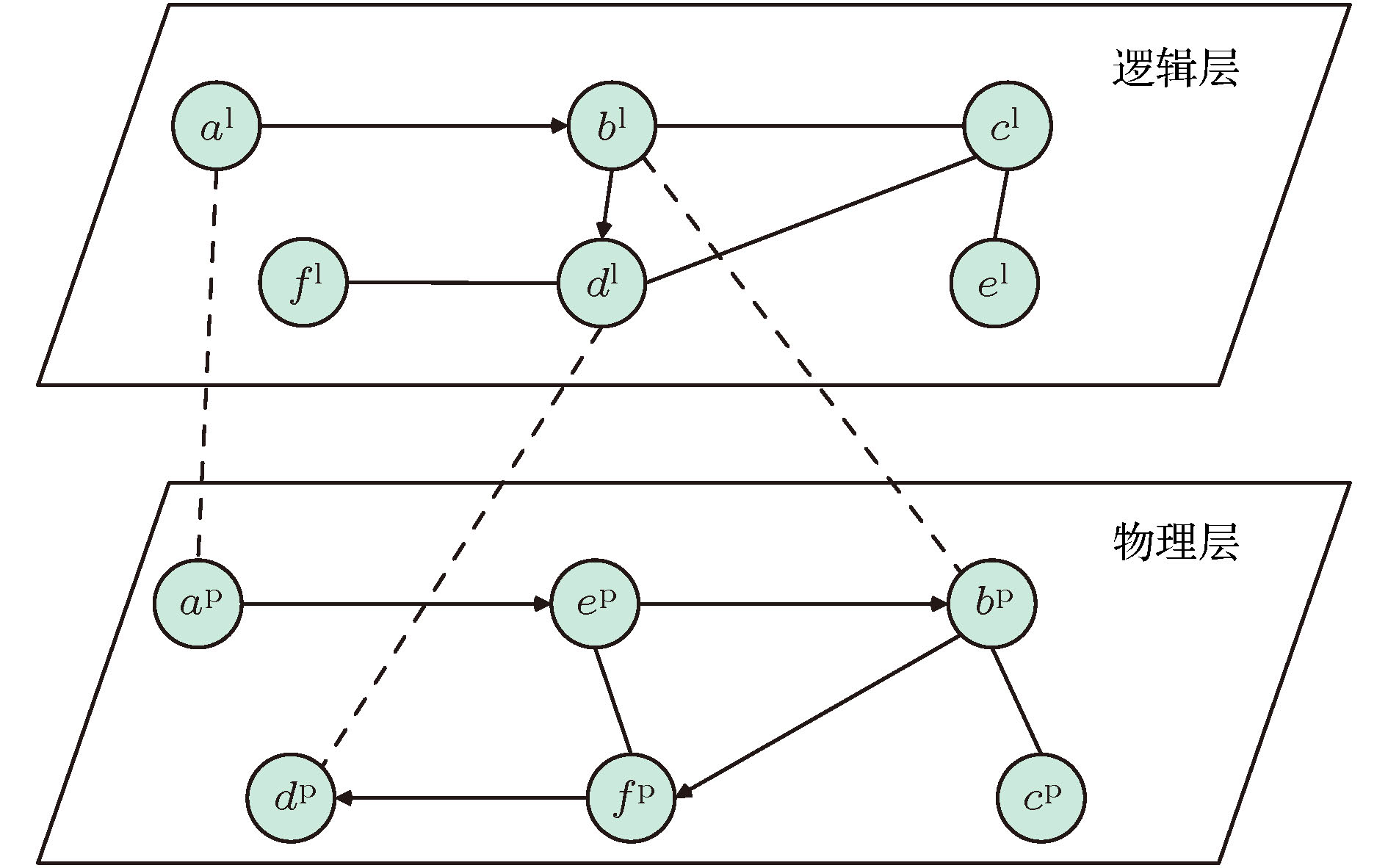
 下载:
下载:
